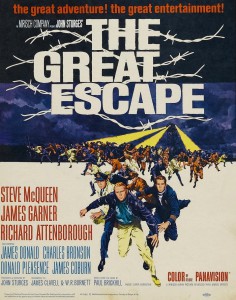The Great Escape is a film that shows teamwork displayed in a drastically different situation, and proves that teamwork is about more than sports, our jobs, or even our families. Teamwork also expands across generations, and can also be born out of extremely dire circumstances. A film about a planned escape from a German prisoner of war (POW) camp by Allied prisoners during World War II. The Great Escape illustrates just how far people will go and to what extent they will work together when faced with adversity.

© film.com – The Great Escape
After the Germans recaptured Allied POWs, they moved the prisoners to a new, higher-security POW camp with the intent of keeping them where they were and deterring them from escaping. In fact, one of the Colonels at the camp emphatically states that “There would be no escapes from the camp.” The Colonel again reiterates the tighter security, and even offers perks to the prisoners for NOT attempting to escape. This was actually the first example of teamwork in the film, grim though it was. In order to come to an agreement on the new camp’s design and security features and move the POWs to the new facility, the German commanders had to work together in order to accomplish their goal.
Quite understandably, there were plenty of POWs at the camp who did not want to stay put, no matter how rich the perks were. And here is where the film presented its second example of teamwork.
The primary (and absolutely amazing) feature of the escape plan was the design of the tunnels, built for facilitating the escape of 250 prisoners. The prisoners worked on three tunnels at the same time, and even gave them names: “Tom, Dick, and Harry.” (The prisoners thought of everything: amazingly enough, they cleverly used the prisoner choir to cover up the sounds of digging the tunnels.) Teams of prisoners were organized to secretly construct the tunnels, obtain contraband materials (such as a camera and ID cards), forge documents, and even make civilian clothes—all done while eluding the watchful prison guards. Additional examples of teamwork: One of the POWs, a USAAF Captain, continually irritates and distracts the guards with frequent individual escape attempts. Although he could have probably fully escaped, this Captain allowed himself to be re-captured. He was able to create maps showing towns and railroad stations from the information he obtained during his brief instances of freedom. Another POW formed a friendship with one of the German guards, and was actually able to persuade the guard to smuggle documents and other contraband that the prisoners needed.
This team of prisoners agreed among themselves that this escape plan was also designed to harass and confuse the enemy so that most resources and troops would be so distracted by searching for the POWs that their effectiveness on the front line would suffer. They also worked together to plan three separate incidents that would ultimately affect the success of their escape plan.
Although ultimately the escape attempt resulted in the recapture or killing of most of the POWs, teamwork was displayed throughout this film, not only by the prison guards, but also from the POWs as they devised their plans.
